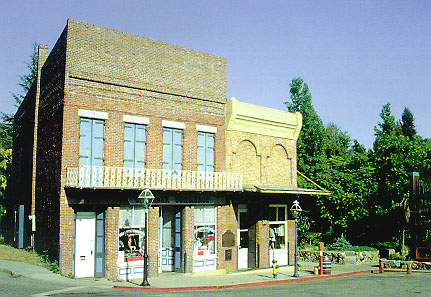

 Ott’s Assay Office is said to have had $27 million in gold pass through its doors without
ever once being held up or robbed. Built sometime prior to the great fire of 1856, this two-story
brick building originally housed the City Drugstore. Ott moved in when his original Assay Office,
a wooden structure located just next door, burned to the ground in the fire of 1863. James J.
Ott, a cousin of John Sutter, holds an important spot in the history of what became the state of
Nevada. In 1859, he made the famous assay of the blue muck that was causing the Washoe miners no
end of trouble, clogging up their workings, difficult or impossible to throw away. But when the
blue muck turned out to be almost pure silver, the news started the fabulous Silver Rush to the
Comstock Lode and Virginia City, Washoe County, Nevada Territory.
Ott’s Assay Office is said to have had $27 million in gold pass through its doors without
ever once being held up or robbed. Built sometime prior to the great fire of 1856, this two-story
brick building originally housed the City Drugstore. Ott moved in when his original Assay Office,
a wooden structure located just next door, burned to the ground in the fire of 1863. James J.
Ott, a cousin of John Sutter, holds an important spot in the history of what became the state of
Nevada. In 1859, he made the famous assay of the blue muck that was causing the Washoe miners no
end of trouble, clogging up their workings, difficult or impossible to throw away. But when the
blue muck turned out to be almost pure silver, the news started the fabulous Silver Rush to the
Comstock Lode and Virginia City, Washoe County, Nevada Territory. The South Yuba Canal Building is one of the oldest business buildings in Nevada City. Built
in 1855, the two-story brick structure was fitted with the standard iron doors and shutters, and
edged with a filigree balcony railing. Originally known as the Potter Building, by 1861 the
structure was home to the offices of the South Yuba Canal Company, which eventually became the
state’s largest water system. Originally established as a consolidation of three rival ditch
companies and known as the Rock Creek, Deer Creek, and South Yuba Canal Company, the name was
shortened to the South Yuba Canal Company in 1870. This company went on to build and operate a
system of reservoirs, water ditches, and flumes which carried billions of gallons of water to
thousands of miles of connecting water systems, which in turn supplied the hundreds of hydraulic
mines in the area. They later entered the utility business, eventually becoming the Pacific Gas &
Electric Company, P. G. & E., one of the world’s largest utility companies. This building is
located at 132 Main Street.
The South Yuba Canal Building is one of the oldest business buildings in Nevada City. Built
in 1855, the two-story brick structure was fitted with the standard iron doors and shutters, and
edged with a filigree balcony railing. Originally known as the Potter Building, by 1861 the
structure was home to the offices of the South Yuba Canal Company, which eventually became the
state’s largest water system. Originally established as a consolidation of three rival ditch
companies and known as the Rock Creek, Deer Creek, and South Yuba Canal Company, the name was
shortened to the South Yuba Canal Company in 1870. This company went on to build and operate a
system of reservoirs, water ditches, and flumes which carried billions of gallons of water to
thousands of miles of connecting water systems, which in turn supplied the hundreds of hydraulic
mines in the area. They later entered the utility business, eventually becoming the Pacific Gas &
Electric Company, P. G. & E., one of the world’s largest utility companies. This building is
located at 132 Main Street.
 Gold Country |  Malakoff Home |